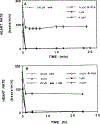Uptake of glucose analogs reflects the rate of contraction of cultured myocytes
- PMID: 10631593
- PMCID: PMC10794912
- DOI: 10.1515/jbcpp.1999.10.4.287
Uptake of glucose analogs reflects the rate of contraction of cultured myocytes
Abstract
The present study demonstrates that: a) adenosine and R-N6-(2-phenylisopropyl)-adenosine (R-PIA, A1 and A3 adenosine receptor agonist) inhibited [3H]deoxyglucose uptake or [3H]3-O-methyl-D-glucose uptake; b) sugar uptake reflects the rate of contraction in cardiac cultures; c) [3H]deoxyglucose uptake or [3H]3-O-methyl-D-glucose uptake are useful quantitative probes for beating rate evaluation. A 25-40% decrease in [3H]deoxyglucose uptake (p < 0.01) was obtained following 13-21 min treatment with 100 microM adenosine together with 1 microM dipyridamole or with 10 microM R-PIA, which inhibited spontaneous contractions. Adenosine (10 microM) attenuated spontaneous beating rate and inhibited approximately 55% of the [3H]deoxyglucose uptake following 22 h treatment (p < 0.01). 1 microM R-PIA also attenuated beating rate following either a short (1 min) or long (24 h) application and decreased [3H]deoxyglucose uptake by 20-30% (p < 0.01) during 0.5-24 h of treatment. A 157 +/- 9% and 205 +/- 11% increase (p < 0.01) in [3H]deoxyglucose uptake was obtained at 27 and 37 degrees C, respectively, compared with the uptake at 17 degrees C, which completely inhibited spontaneous contractions. Similar results [33 +/- 6% (p < 0.01) and 21 +/- 8% (p < 0.05) inhibition in [3H]deoxyglucose uptake] were obtained following 2 and 22 h of carbamylcholine treatment, respectively. This treatment also reduced spontaneous contractions. [3H] 3-O-Methyl-D-glucose uptake also decreased by 31 +/- 12% (p < 0.05) as a result of the arrest of contractions by adenosine. Elevations of 90 +/- 13% and 34 +/- 11% (p < 0.01) in [3H]deoxyglucose uptake were obtained following treatment with isoprenaline after 2 and 22 h application, respectively. It is concluded that adenosine and R-PIA inhibited [3H]deoxyglucose uptake or [3H] 3-O-methyl-D-glucose uptake in rat heart culture and that there is a linkage between the rate of cardiac contractions in culture and sugar uptake.
Figures







References
-
- Sokoloff L, Reivich M, Kennedy C, des Rosiers MH, Patlak CS, Pettigrew KD, Sakurada O, Shinohara M. The 14C deoxyglucose method for the measurement of local cerebral glucose utilization: theory, procedure, and normal values in the conscious and anesthetized albino rat. J Neurochem 1977; 28: 897–916. - PubMed
-
- Saje M, Obata K. Stimulus-dependent labeling of cultured ganglionic cell with 4C-deoxyglucose. Brain Res 1981; 212: 435–446. - PubMed
-
- Shainberg A, Pearl R. Activity of muscle cultures measured by 2-deoxy-glucose uptake. Int J Dev Neurosci 1983; 1:267–271. - PubMed
-
- Kennedy C, Des Rosiers M, Fehle FW, Reivich M, Sharp F, Sokoloff L. Mapping of functional neurol pathway by autoradiographic survey of local metabolic rate with 14C deoxyglucose. Science 1975; 187: 850–853. - PubMed
-
- Bogaert J, Maes A, Van de Werf F, Bosmans H, Herregods MC, Nuyts J, Desmet W, Mortelmans L, Marchal G, Rademakers FE. Functional recovery of subepicardial myocardial tissue in transmural myocardial infarction after successful reperfusion: an important contribution to the improvement of regional and global left ventricular function. Circulation 1999; 99: 36–43. - PubMed
Publication types
MeSH terms
Substances
Grants and funding
LinkOut - more resources
Full Text Sources
